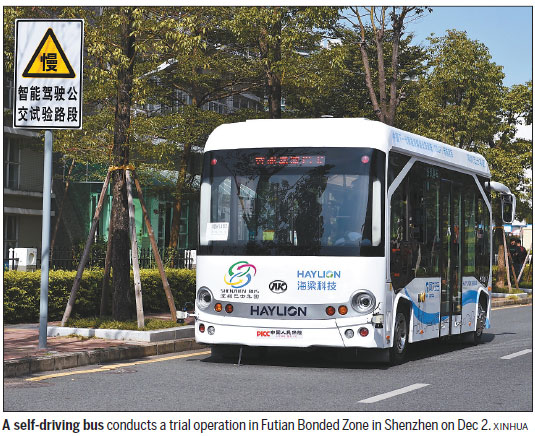Driverless buses begin trial run

Four smart buses began a trial operation in Futian Bonded Zone in Shenzhen on Dec 2.
The smart buses, which are smaller than ordinary buses and equipped with lidar sensors, cameras and GPS antennas, hit the road on a 1.2-kilometer route with three stops. They were able to avoid pedestrians, vehicles and barriers, safely change lanes and stop at designated sites.
The buses cruise at designed speeds of 10 to 30 kph with a driver who manually brakes or switches the vehicle to manual driving mode in an emergency. With 17 seats, the buses can each carry 25 passengers. It can be fully charged in 40 minutes and can cover 150 km on a single charge.
During the trial operation period, the buses are only open to invited passengers and used for collecting data.
The project was jointly developed by the National Intelligent Transport Systems Center of Engineering and Technology and Shenzhen Bus Group, and implemented by Shenzhen Haylion Science and Technology.
Yu Gang, chairman of Shenzhen Bus Group, said at the launching ceremony: "The intelligent bus system Alphaba has met the necessary requirements concerning stability, safety and reliability to conduct a trial operation."
"The system integrates multiple technologies, such as artificial intelligence, automatic control and visual computation. It has seven layers of safety protection, including lidar sensors, cameras and a GPS antenna, to analyze the road situation and respond in a timely manner," said Hu Jianping, founder and chairman of Haylion.
Riders can pay with their Shenzhentong cards or by scanning a QR code. Passengers from Beijing, Chongqing, Nanjing, Suzhou and Guangzhou can also pay with their local transport cards.
The buses will also go for a test drive on the less congested urban roads at the Southern University of Science and Technology and in the Guangming and Dapeng new areas in Shenzhen.
As a national model project, the system will be promoted in 10 cities in future.
The driverless buses are expected to lower emissions significantly, solve traffic problems with their advanced data sharing abilities, and reduce labor costs and relieve drivers' workload.
By August, the number of daily bus commuters in Shenzhen had reached 10.67 million, with more than 16,000 buses on the roads, according to a Shenzhen Commercial Daily report in September.
Several countries and regions, such as Singapore, the United Kingdom, the United States and France, started trial operations for autonomous buses this year.

MOST POPULAR
- 1 $39.7 billion worth of deals inked at Airshow China
- 2 China announces tax relief measures to stabilize real estate sector
- 3 A look at China's economy in October, 2024
- 4 Public holiday extension announced
- 5 China's NEV annual production hits 10 million milestone amid global carbon reduction efforts
Editors' Picks
 Infographic:
A look at China's economy in October, 2024
Infographic:
A look at China's economy in October, 2024
 Infographic:
G20 at a glance
Infographic:
G20 at a glance
 Video:
Peru sees new port open
Video:
Peru sees new port open
 Infographic:
China's public holidays for 2025
Infographic:
China's public holidays for 2025
 Infographic:
Basic facts of APEC
Infographic:
Basic facts of APEC


